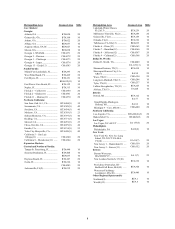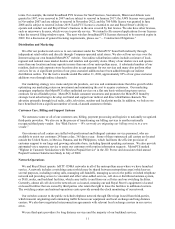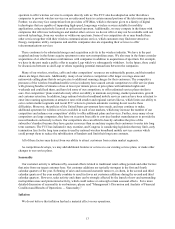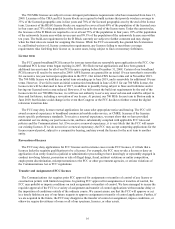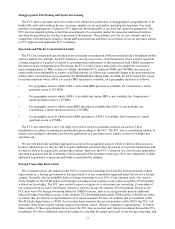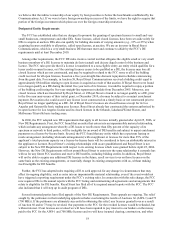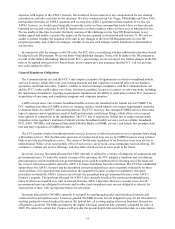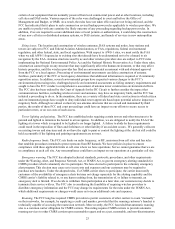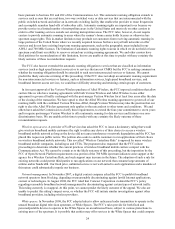Metro PCS 2008 Annual Report Download - page 23
Download and view the complete annual report
Please find page 23 of the 2008 Metro PCS annual report below. You can navigate through the pages in the report by either clicking on the pages listed below, or by using the keyword search tool below to find specific information within the annual report.14
Employees
As of December 31, 2008, we have approximately 3,200 employees. We believe our relationship with our
employees is good. None of our employees are covered by a collective bargaining agreement or represented by an
employee union.
Regulation
The wireless telecommunications industry is regulated extensively by the federal government and, to varying
degrees, by state and local governments. Congress, state legislatures, municipalities, federal, state and local
regulators, and the courts have passed legislation, ordinances, codes, rules, regulations, instituted administrative
rulemakings, and issued judicial decisions, affecting the telecommunications industry. Due to the recent changes in
the party affiliation of the President of the United States and changes in the composition of Federal and state
legislatures, the political environment, and financial conditions, the regulation of the communications industry has
been, and is expected to remain in the future, in a state of constant flux. Many of these legislative actions,
rulemakings, and judicial decisions have had, and possible future regulations may have, a significant material effect
on us, our business, our financial condition, and our operating results.
Federal regulation
Our business is subject to extensive federal regulation under the Communications Act of 1934, as amended, or the
Communications Act, the implementing regulations adopted thereunder by the FCC, judicial and regulatory
decisions interpreting and implementing the Communications Act, and other federal statutes as discussed below.
These statutes, regulations and associated policies govern, among other things, the allocation and licensing of radio
spectrum; the ownership, lease, transfer of control and assignment of wireless licenses; the ongoing technical,
operational and service requirements under which we must operate; the timing, nature and scope of network
construction; the rates, terms and conditions of service; the protection and use of customer information; roaming
policies; the provision of certain services, such as E-911; the interconnection of communications networks; the
provision of subscriber equipment; the location of network assets; and the use of rights of way.
Broadband spectrum allocations
We utilize paired radio spectrum licensed by the FCC. The principal spectrum bands used to provide terrestrial
broadband wireless mobile services in the United States are as follows, all of which can be used to provide services
competitive with the spectrum held by us:
Cellular spectrum. Starting in the 1980’s, the FCC awarded two cellular licenses with 25 MHz of spectrum each
in the 800 MHz band on a metropolitan statistical area, or MSA, and rural service area, or RSA, basis. There are 306
MSAs and 428 RSAs in the United States. MSAs and RSAs are defined by the Office of Management and Budget
and the FCC, respectively.
PCS spectrum. In the 1990’s, the FCC assigned licenses to use 120 MHz of radio spectrum in the 1.9 GHz band
for broadband PCS. The FCC divided the 120 MHz of spectrum into two 30 MHz blocks licensed on a Major
Trading Area, or MTA, basis, and one 30 MHz block and three 10 MHz blocks licensed on a Basic Trading Area, or
BTA, basis. Under the broadband PCS licensing plan, the United States and its possessions and territories are
divided into 493 BTAs, all of which are included within 51 MTAs. Both MTAs and BTAs are defined by Rand
McNally & Company, as supplemented by the FCC. Many of our competitors utilize a combination of cellular and
broadband PCS spectrum to provide their services. In addition, the FCC granted a nationwide 10 MHz paired PCS
license to Nextel Communications (now Sprint Nextel) in conjunction with its relocation and rebanding of ESMR
spectrum.
SMR spectrum. The FCC first established specialized mobile radio, or SMR, in 1979 to provide for land mobile
communications on a commercial basis. The FCC initially licensed spectrum in the 800 and 900 MHz bands for this
service, in non-contiguous bands, on a site-by-site basis. Since then, the FCC has established geographic area
licenses for such spectrum. In total, the FCC has licensed 19 megahertz of SMR spectrum, plus an additional 7.5
megahertz of spectrum that is available for SMR as well as other services. FCC policy permits flexible use of this
spectrum, including the provision of mobile wireless services, and such spectrum is taken into consideration when
the FCC is assessing the competitive impact of broadband wireless merger and acquisition transactions.






